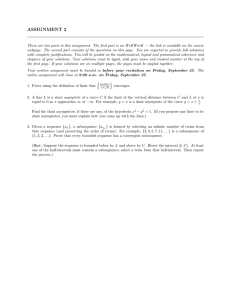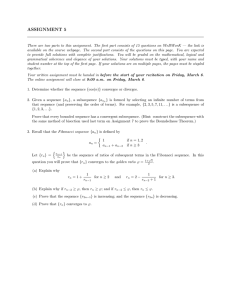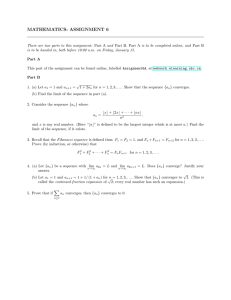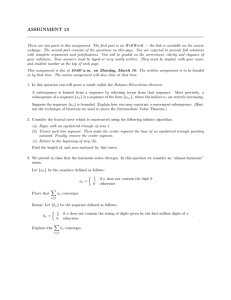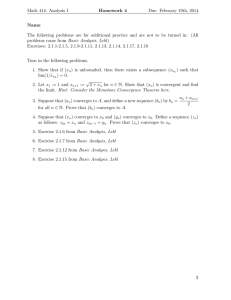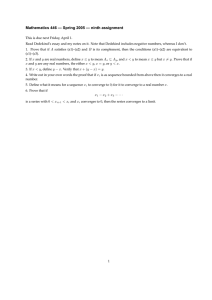ASSIGNMENT 2
advertisement
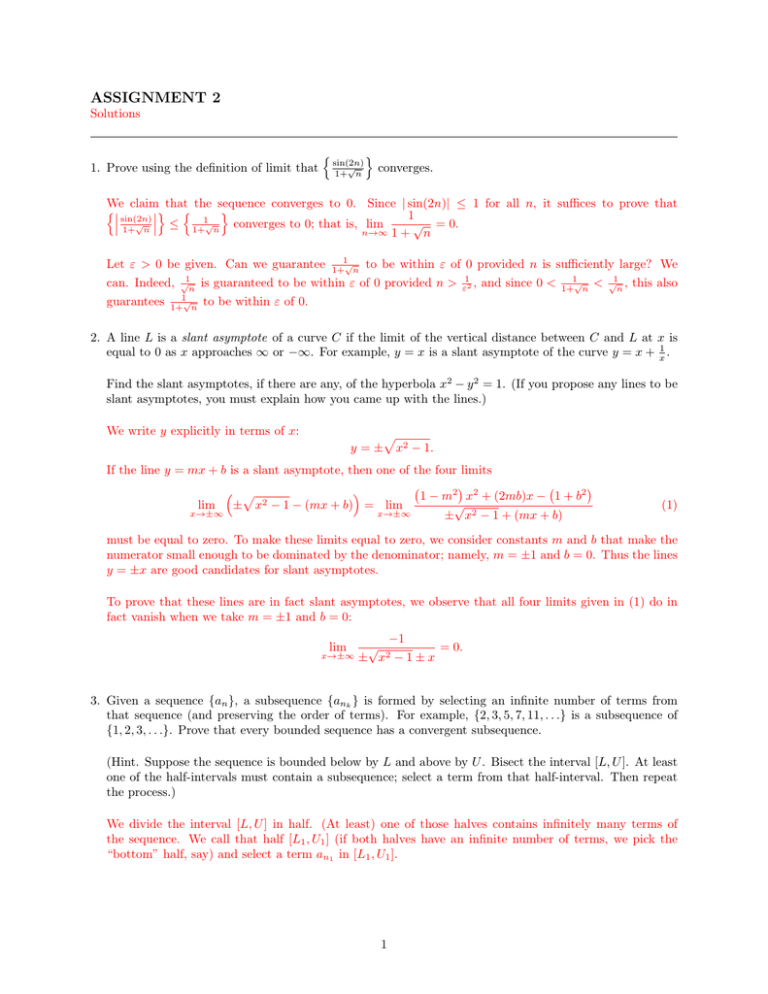
ASSIGNMENT 2
Solutions
1. Prove using the definition of limit that
n
sin(2n)
√
1+ n
o
converges.
We claim that the sequence converges to 0. Since | sin(2n)| ≤ 1 for all n, it suffices to prove that
o n
o
n
1
sin(2n)
√ = 0.
1+√n ≤ 1+1√n converges to 0; that is, lim
n→∞ 1 +
n
Let ε > 0 be given. Can we guarantee 1+1√n to be within ε of 0 provided n is sufficiently large? We
can. Indeed, √1n is guaranteed to be within ε of 0 provided n > ε12 , and since 0 < 1+1√n < √1n , this also
guarantees 1+1√n to be within ε of 0.
2. A line L is a slant asymptote of a curve C if the limit of the vertical distance between C and L at x is
equal to 0 as x approaches ∞ or −∞. For example, y = x is a slant asymptote of the curve y = x + x1 .
Find the slant asymptotes, if there are any, of the hyperbola x2 − y 2 = 1. (If you propose any lines to be
slant asymptotes, you must explain how you came up with the lines.)
We write y explicitly in terms of x:
p
y = ± x2 − 1.
If the line y = mx + b is a slant asymptote, then one of the four limits
p
1 − m2 x2 + (2mb)x − 1 + b2
2
√
lim ± x − 1 − (mx + b) = lim
x→±∞
x→±∞
± x2 − 1 + (mx + b)
(1)
must be equal to zero. To make these limits equal to zero, we consider constants m and b that make the
numerator small enough to be dominated by the denominator; namely, m = ±1 and b = 0. Thus the lines
y = ±x are good candidates for slant asymptotes.
To prove that these lines are in fact slant asymptotes, we observe that all four limits given in (1) do in
fact vanish when we take m = ±1 and b = 0:
lim
x→±∞
−1
√
= 0.
± x2 − 1 ± x
3. Given a sequence {an }, a subsequence {ank } is formed by selecting an infinite number of terms from
that sequence (and preserving the order of terms). For example, {2, 3, 5, 7, 11, . . .} is a subsequence of
{1, 2, 3, . . .}. Prove that every bounded sequence has a convergent subsequence.
(Hint. Suppose the sequence is bounded below by L and above by U . Bisect the interval [L, U ]. At least
one of the half-intervals must contain a subsequence; select a term from that half-interval. Then repeat
the process.)
We divide the interval [L, U ] in half. (At least) one of those halves contains infinitely many terms of
the sequence. We call that half [L1 , U1 ] (if both halves have an infinite number of terms, we pick the
“bottom” half, say) and select a term an1 in [L1 , U1 ].
1
Again, we divide [L1 , U1 ] in half, select a half [L2 , U2 ] with infinitely many terms of the sequence, and
select a term an2 in [L2 , U2 ].
We repeat the process ad infinitum, getting a subsequence {ank } with terms in the sequence of nested
intervals
[L1 , U1 ] ⊃ [L2 , U2 ] ⊃ [L3 , U3 ] ⊃ · · · ,
respectively. {ank } converges. To see this, note that {Lk } is an increasing, bounded sequence, which
therefore converges to a number A. Similarly, {Uk } is a decreasing, bounded sequence which converges
to
,
a number B. It remains only to show that A = B; this follows from the fact that {Uk − Lk } = U2−L
k
which clearly converges to 0.
2
